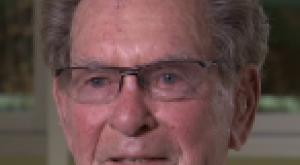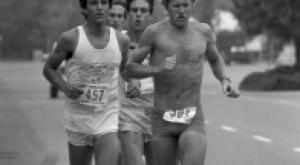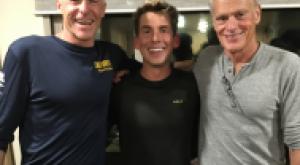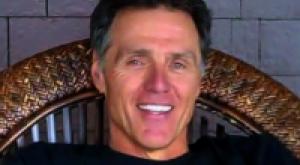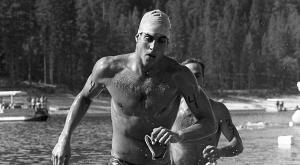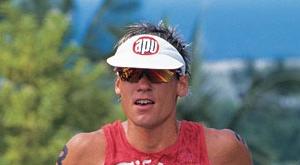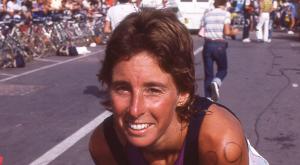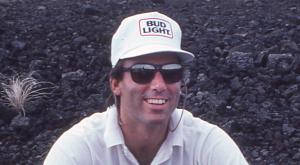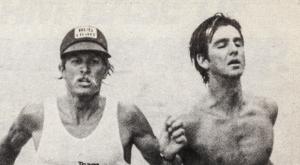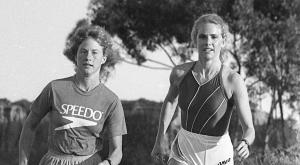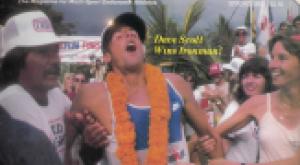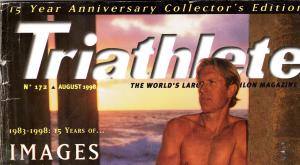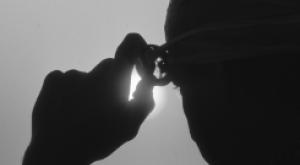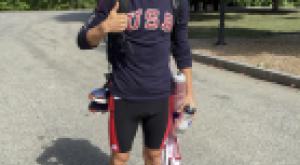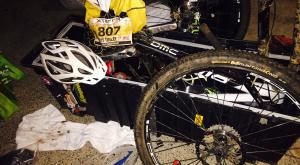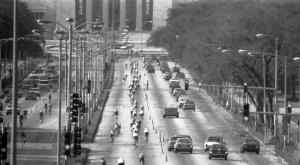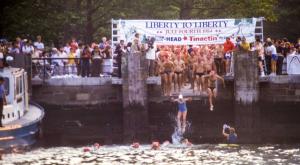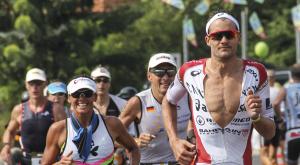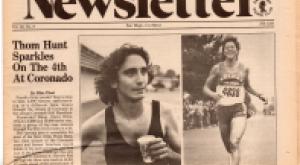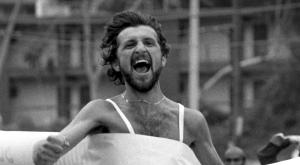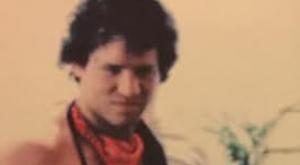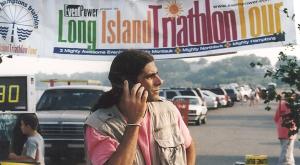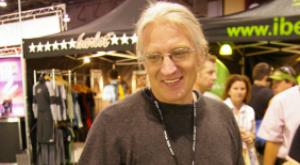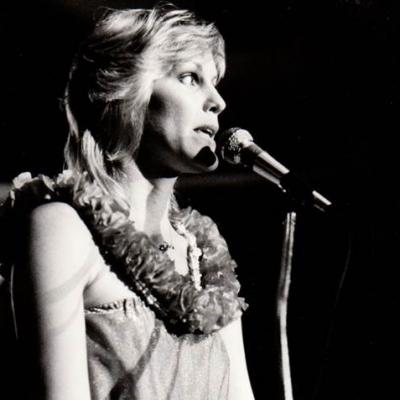
Valerie Silk, addressing the Ironman award ceremony (circa 1985)
In part 1, Silk discussed how she acquired the Ironman, why and how she moved it Kona from Oahu, and the early parts of taking the race commercial. Her tale of the Feb. 1982 event where she missed the Julie Moss/Kathleen McCartney episode is the stuff of legend.
In part 2, Valerie offers additional thoughts on those seminal years, her sale to Dr. James Gills of Florida, the current sale-in-works to the Chinese multinational corporation, Dalian Wanda, and her own forgotten legacy within triathlon.
ST (Scott Tinley): Wait a minute. Are you saying you missed the entire Julie Show?
VS: I was told Julie was in the med tent. So I went to see her. On the way, I was met by Diana Nyad, the distance swimmer, who also was a color commentator for ABC that year. Diana gave me a hug and said, “Don’t let those guys get you down, Val.” I thanked her for her kindness, as I fought hard against tears.
Julie was on a cot in the med tent. She actually looked great. I sat down on the cot next to her. She said, “Well, Valerie, do you think second place is good enough to let me come back next year?”
I remember admiring her indomitable spirit and smiling at her question. “Sure, Julie. It’s good enough to come back next year,” but I knew there wouldn’t be a next year.
ABC’s habit was to postpone the Ironman broadcast for a few months after the event, but not this time. The Feb. ’82 race aired only two weeks later. Then Wide World of Sports did something unprecedented in its history. The response to the show was so tremendous that ABC televised it again only two weeks after the first broadcast.
Suddenly, I was being contacted by sports marketing agents who wanted to help me find sponsors. Sponsorship potential did increase greatly. I was so glad for the little bit of reason I exercised when I refused to sign a 3-year contract with Anheuser-Busch.
Interest in the Ironman surged. For the first time, the number of requests for applications far exceeded the number we could accommodate on race day. Soon the Ironman lottery would be born.
Months later, someone sent me an article from the New York Times. Weisman was interviewed as the producer of this newly famous Ironman show. The reporter asked him whether he knew what he had when he saw the footage. “Oh, yes!” he said. “We instantly knew this was going to be a hit.”
I remember sitting in my office in Honolulu, reading that, and laughing out loud. What delicious irony there is in life sometimes.
ST: Well, Weisman is no longer with us so he can’t respond. But who would you count as key lieutenants that served the event during that pivotal 1980s decade? Bob Laird? Kay Rhead? Jan (the swim coordinator)? Generally, how challenging was it to build a relationship with the city of Kailua Kona during that period?
VS: As mentioned in #6, Earl Yamaguchi was the most important person—really the only other person—working with me on the Ironman when we were just getting started in 1980. I did spend a lot of time on the Big Island making contacts. My first Big Island contacts were Mo and B’Gay Mathews, who became my swim directors. Curt and Leslie Tyler were good friends of the Mathews. They became directors as well. Those two couples had an excellent network of friends in the swimming and business communities and were instrumental in putting together a core volunteer team for the ’81 race.
Over the years, I became quite close to Kay Rhead after appointing her as race director. Shirley Starr, who was my friend in Honolulu and later became my administrative director, was very much a confidant and is still a great friend. Of course, all the volunteer directors who were responsible for the various divisions of the race were terrific. I enjoyed being with all of them, but once I pulled away from the role of race director, I didn’t have the pleasure of interacting with them as much as I had before, which I missed.
It wasn’t difficult at all to build a relationship with Kailua-Kona. What made it so easy was the fact that Kona was such a small town. Everybody knew everybody. Once a few people became excited about the idea of the Ironman, especially that ABC would be coming to town, it wasn’t hard to get others excited, too.
Thinking back, ABC really was the ticket. Hawaii is a tourist destination and depends heavily on that source of income. The more free publicity, the better. I think I probably had little difficulty getting permits to close roads and highways because there would be film crews on them. The Ironman had serious economic impact on Hawaii. Apart from the excitement of the athletic event, it was good business.
ST: There must’ve been some tough times as the event grew and everyone wanted something from you. Was there ever a moment when you thought it just wasn’t worth the trouble?
VS: At the conclusion of my first Ironman event in 1981, I was convinced that I had failed in a spectacular way. I returned to Honolulu, humiliated and downcast. I shut myself in my apartment for three months, emerging only when I needed groceries. I was devastated and utterly ruined emotionally. I remember calling all of my key volunteers, unsure whether they would even speak to me. I apologized, through tears, for putting them through such an ordeal. Ironically, they were already full of ideas for the next event, but I was inconsolable. I didn’t want to hear any of it. I was done.
What eventually brought me out of my seclusion was a call from a triathlete in Honolulu. I’ll never forget him. Dennis Hansen was his name. He did the race that year, and as I remember, he called me for information about the next event. I told him I wasn’t going to organize another one. He tried to dissuade me from giving up, but my mind was set. He asked if I would consider attending a party where he and a group of triathletes would be gathered. That’s not something I normally would do in my best humor. I certainly wasn’t interested in my despondency, but he was persistent and finally persuaded me to go.
At the party, I received so much encouragement that I was actually confused by it. For some reason, they didn’t think I had failed quite as abysmally as I was sure I did. To this day, I would still disagree with them. Nevertheless, they made an appeal that I not walk away from the Ironman. Eventually my spirits were buoyed by all the enthusiasm for another race, and by the end of the evening, my sights were once again turned towards Kona. Perhaps I could redeem myself in 1982.
Of course, the Feb. ‘82 race, in my opinion, was the pivotal event in all of Ironman history. It was do or die. I thought it was die. I’ll address why in my response to #8.
In answer to your question of whether there was a moment when I thought the Ironman just wasn’t worth the trouble: yes, yes, and yes. There were many, many times when that thought entered my mind and darkened my mood. It was usually when I was overwhelmed by circumstances and weary to my bones, but I learned to take a moment when I reached that point to do a quick assessment. In the final analysis, I always concluded that the positives outweighed the negatives, and on that basis, I would carry on.
But there did come a time when I reversed that position and decided that none of it had been worth it. Oddly, that point came well after I was gone from the Ironman stage. It was related to my legal entanglements with WTC—a subject you raised in your latest email, but I’ll conclude this segment for now.
ST: What were your thoughts going into selling the Ironman? How did it come that you decided on Dr. Gills as, I believe, there were a number of interested parties? Can you discuss any of the details of the agreement? Wasn’t there a subsequent proceeding that he brought against you regarding use of the M-Dot logo for apparel? (I believe Mistral owned that mark?). As he brought in his people to run the event, how did you feel about their strategies?
VS: My thoughts about selling the Ironman began very early—not the selling, per se, but the getting out. As mentioned earlier, I was ready to make my exit after my first race in 1981. It would have been easy to walk away then, but I was persuaded to stay. After a couple more years, it was a lot more complicated to extricate myself because of the corporate structure and the size of the event. I felt trapped, with no way out.
The ten years I spent with the Ironman were the hardest, most stressful, most terrifying years of my life. I went into it without knowing what I was doing, and throughout the entire decade, I never knew what I was doing. I had a tiger by the tail. All I could do was hang on for dear life.
Jim Gills became the chosen buyer after the fiasco with Marshall Medoff, whom I had previously considered as a potential buyer. The agreement to sell to Medoff ended up in a terrible legal tangle, which was finally won on summary judgment, as I remember. By then, it was public knowledge that I wanted to sell.
After the race one year, David Voth asked for a meeting, in which he proposed the idea of Jim Gills purchasing the Ironman. David and Jim were friends. Both lived in the Tampa Bay area, where I grew up, and both had competed in the Ironman and loved the event.
I was skeptical at first, but further investigation revealed their serious intent, their ability to complete the purchase, and their sincerity to preserve the integrity and prestige of the race.
It’s been 26 years since the sale, so the details of the agreement are sketchy in my memory. Scott, you may know the sale price better than I do. I think it was either $2.1 or $2.3 million. I can’t remember. (I never had a head for money or numbers.)
Editor’s Note: Other reliable sources have placed that figure at closer to $3million. My hunch is that that after the lawsuits were finalized, the figure (due to Silk after splitting with her partner, capital gains taxes, fees, et al. was closer to the $500,000k than $3 million. Perhaps quite a bit less). Of course the readers must make their own conclusion of what Valeria Silk, for her decade of zealot-level attention to the Ironman Triathlon and all that it meant to her and The Great Followers, was worth in material valuation.
VS: The closing took place in Tarpon Springs, FL, on December 4, 1989. I wasn’t able to make the trip from Hawaii. So my attorney was present, and one of my sisters sat in on the proceedings.
I later learned that WTC (Gills’ newly formed business entity—World Triathlon Corp.) tried to negotiate the price down at the closing! With that move, my attorney slammed his briefcase shut, announced that the deal was off, and stood up to walk out. The WTC representatives suddenly regained their senses, and the closing was finalized.
There was a subsequent proceeding brought against me by WTC regarding the use of the M-dot in the word “Ironman.” I believe I went over the details of that in our phone conversation. It was ultimately resolved through mediation and involved a settlement, the amount of which I can’t remember.
I remember making a call once to David Voth after hearing complaints from Kona that the volunteers felt they were being treated in a heavy-handed way. Changes were being made without any input from them.
I called David to reiterate the point that I made strenuously to him several times before: input from the volunteers in Kona must be sought and should be given every reasonable consideration. He needed them and would not be able to treat them as though they were paid employees.
He listened patiently and assured me that he had everything under control, and all would be well. That was the extent of my involvement with the race after the sale.
I know that, whenever there’s a change in management, grievances usually follow. I think, overall, things went very well. The Ironman continued to thrive and grow, which is exactly what I hoped for.
Additional thoughts from V. Silk:
ST: What did it feel like to move beyond your involvement in building the event if not the brand? Were you thoughtful of your legacy?
VS: I didn’t think too much about a legacy. I just did what I did. There are few people around me who even know that I was involved with it (Ironman) before so it’s not part of my daily conversation. I was very glad to place the Ironman in the hands of people that I hoped would take the Ironman to a level that I knew I wouldn’t. It grew to a level that I was no longer the Race Director, the place I wanted to be…I ended up becoming more involved in business and politics than I wanted to; that’s not my forte and I felt like a fish out of water all the time.
I knew the Ironman had reached a point when I knew it needed to be taken to a new level and if I stayed…it was just going to stagnate…I was just really burnt out anyway. It was an amazing lesson of what can happen when a company goes up for sale. Things start to happen that you never expect.
I didn’t want it publicly known that I was trying to sell. I was dealing with a large volunteer force in Kona…I wanted the Ironman not to get rocked…I made a hugely bad decision in agreeing to sell to group after they had done their due diligence and they really messed things up badly. I wish I could remember; it’s been two and half decades.
There were entities like the networks that starting getting nervous. Eventually we did a deal with Dr. Jim Gills but he was always in the background. I never had any deals with him; he always had his front-men doing the work. But we never really sat down…Years later when I took my mom up to his clinic for cataract surgery he was very cordial.
I ended up having like, five lawsuits,” she continues, that developed before the closing, and…this is a supposition on my part but (I feel) I was viewed as the naïve…I won’t say ‘bubblehead’ but a kind-of-girl-who-didn’t know-what-I-was-doing and she was leading the Ironman. But the big boys were going to come into town and they were going to do things right. Still, I had these lawsuits to deal with…”
ST: Do you recall the bases for any of the suits?
VS: I’m trying to remember but it seems some of the sponsors felt a threat to their existing contracts. I don’t remember all the specifics but I had to quiet everybody down.
Editor’s Note: Silk offers some vague details about one lawsuit that was brought to her by Dr. Gills’ new corporation, World Triathlon Corporation, after the sale of the brand to his group that dealt with the use of the mark (M-Dot) for the sale and distribution of apparel. She notes that Mistral, a French sailboarding company, had shown some concerns when the now-licensed, M-Dot mark was first being used by Ironman in the mid to late 1980s by her and her sponsors on apparel. An agreement was made between Silk’s Ironman brand and Mistral for limited use of the M-related mark exclusive of a sustainable line of apparel using the mark. Apparently, the details of this agreement and how and why this concern was never fully explored and negotiated in the sale and are so vague as make any conjecture a fruitless exploration. “Amongst the stacks of paperwork that they (WTC) were sent,” Silk offers, “that short agreement with Mistral was missing.” The suit was amicably settled and WTC went on to build the brand for many years.
Later in the conversation she notes that “in those early years we had more challenges with Marvel (Comics) than Mistral.” Marvel Comics, as is widely known, owns the original generic ‘Ironman’ name.
ST: WTC is currently in talks to sell the Ironman brand to the Chinese finance and real estate company, Dalian Wanda for a reported $850 million dollars. How did that news sit with you?
VS: I don't really have that much to say about the possible sale price, except that the sheer size of the number took my breath away. But then, the price paid to Gills by Providence Equity did the same. I'm afraid I don't have the benefit of your perspective as a professional triathlete, which informs your opinion of the matter… It's confusing to me, but I admit to naiveté in these things.
My first inclination about the new sale negotiations is to say, "Good for them!" Of course, I hope the spirit and the quality of the Ironman will be preserved. Only time will tell. The people of Kona are rightly proud of the event they built. No doubt they'll work hard to maintain its integrity. I do wonder what it might mean for the Ironman to be owned by the Chinese and how that will influence the administration of all the events.
I heard complaints after I left, in 1989, that "things weren't the same anymore." Over the years, there have been more comments about how Ironman has become "big business." Perhaps that's to be expected. The race and the sport have grown immensely since 1978, when 15 men stepped into the waters at Waikiki to begin the first Ironman Triathlon.
As far as the disparity between the original sale price and the current offer, I can only say, if the buyer thinks the company is worth that amount, then I don't see that the seller is under any obligation to reduce the price. Apparently, that's what the market will bear.
The Ironman has certainly far exceeded all of my expectations for it. I hoped it would grow and prosper after I left, and it certainly has--way beyond what I ever could have imagined!
I can't remember the exact price my partner and I were paid by Gills in December 1989. I think it was slightly over $3 million, of which I received 51%. Most of that amount was siphoned off within the first 3 years. The biggest predator was our government, which confiscated 50% right off the bat. That was the capital gains rate at the time. President Reagan substantially reduced that rate after he was elected, but it didn't take effect until after the closing. Since I started with nothing, 100% of the sale price was taxable.
It was disheartening, to say the least, to work 10 of the hardest years of my life, and to put everything I owned on the line, only to have the IRS confiscate the fruit of half of that decade. I have much less problem with an Ironman sale of 850 million dollars, where neither party is coerced into buying or selling, than I do with the coercive arm of government that can seize such a large portion of the fruits of our labors. That's immoral.
Another drain on the proceeds from the sale was the litigation I carried with me after the closing. As mentioned before, I had to indemnify Gills against lawsuits still active at the time of the sale. It took 3 years to bring those to an end, at no small cost.
Also, I was guided to a financial advisor, who managed the remaining proceeds from the sale. Under normal circumstances, all would have gone well, I'm sure, but unfortunately, that was the era of the "Junk Bond King," Michael Milken, and Ivan Boesky of the insider trading scandal. Many, many people lost huge sums in the market, and I was among them.
I recently read a blog post about Jim Gills, which listed his many accomplishments. Among them was the fact that he bought the Ironman from me for "pennies on the dollar." Apparently I greatly undervalued the company when I sold it. Who knows what he would have paid for it? But that's all water under the bridge. The IRS still would have taken 50% of the proceeds. I still would have gone through 3 years of litigation after the sale, and I still would have lost a huge amount in the stock market, along with so many others at that time.
One thing is certain for me, and that is that I am very, very content to be in Florida with my family and quite relieved that I'm no longer involved in the politics or business of sports. I was always a "fish out of water" in that setting, being neither an athlete nor a business person.
My reaction to the possible sale of the Ironman for the staggering amount of $850 million dollars is really pretty neutral. I hope all Ironman events continue to provide venues for the demonstration of excellence, both organizationally and athletically. I hope the sport continues to thrive and grow. The position I take on the negotiations between buyer and seller is that it's none of my business, and for that I'm glad.
ST: You’ve been essentially removed from the event and the sport for what, nearly 17 or 18 years? What do you miss and what are you glad to be removed from? What would Ironman look like today if you had remained in control for all these years? Would you like to visit the event some day?
VS: I will have been gone from the Ironman for 26 years, as of this December. What I miss is the interaction with the people. I was blessed beyond measure to be surrounded by a superior team of incredibly capable, resourceful, creative, hard-working staff and volunteers. They made me look good. They did the work, and I ended up getting the credit. Memories of my time with them will always be precious to me. I’ll be forever in their debt.
What I don’t miss is the relentless stress. I don’t miss the business and politics of sport. I don’t miss the incredible strain of being responsible for people’s lives on race day.
If I had remained in control all these years, the Ironman would probably not look much different than it did when I left. I would have stifled it. I knew it had reached a point where it needed to be taken to another level, but I had neither the desire nor the ability to do that. It was time to pass the baton. And I was quite ready to do that.
Perhaps one day I’ll visit the Ironman again. Right now, I’m so happy and so grateful to be home with my family—my 7 siblings, 11 nieces and nephews, 8 grand nieces and nephews, and a great-grandniece.
My years with the Ironman are a distant memory now. My present is so radically different from my past. Here’s the contrast: I spent 10 years with the Ironman. I’m glad for the experience, but I’d never, ever want to do it again. On the other hand, I spent 11 years taking care of my mom and dad and a brother disabled by a stroke. I’d give anything to do that again. Both were intensely challenging, but one was infinitely more rewarding and of far greater consequence than others.

